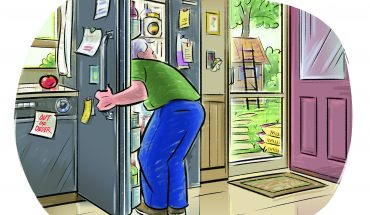by Addie Ladner | photography by Tyler Cunningham

You may have noticed an RV parked in neighborhoods across Wake County with a picture of a cheeseburger sandwiched between two books on the exterior. No, it’s not an extra-quirky family heading out of town—that camper is actually one of local nonprofit Read and Feed’s classrooms-on-wheels. Founded in 2007 by Wake County school volunteer Jan Frantz, the Read and Feed RVs park in low-income neighborhoods to deliver the gifts of words and warm meals to over 600 children annually.
Frantz came up with the idea for a mobile classroom when she noticed that many of the kids she tutored couldn’t access after-school resources due to transportation issues. Those issues were keeping their literacy skills from improving as they should, and what’s more, those kids were often from low-income families struggling to put food on the table. Her solution? Go to the kids. “Jan essentially created a mobile classroom. She noticed that these children were coming from the working poor and so she decided to feed them too,” says Kati Mullan, executive director at Read and Feed.

The need for a program like Read and Feed in Wake County is great: Last year, over 58 percent of Wake County’s low-income third-graders failed to read at grade level, and nearly 40 percent of elementary school-aged children are on low-or reduced-priced lunches. Teachers refer students to the program who are identified as at risk for falling below grade-level reading or who are in need of tutoring. “There is a direct correlation between children who are low-income and children who are not reading at grade level,” says Mullan. Read and Feed’s impact aims to put a dent in those numbers. Mullan credits the organization’s success to the hundreds of volunteers, community sponsors and fellow nonprofits who support their mission. Many of the Read and Feed sites are in food deserts, and groups like Inter-Faith Food Shuttle work with them at most sites to provide healthy meals such as roast chicken, green beans and fresh fruit to the children.

Each RV has been outfitted as a playful, comfortable and engaging classroom for up to 24 children at a time, and Mullan says the children love spending time in the RVs. Step into one of the newly redesigned 2011 Fleetwood Bounders and it’s easy to see why: Chalkboard paint covers the cabinet doors and brightly-colored Dr. Seuss quotes decorate the walls. The RV bedrooms serve as mini libraries filled with books for kids to check out, and each RV has a dollar store-style nook where kids can pick out trinkets as a reward for their reading progress. However, Read and Feed is much more than just a classroom and cafeteria, says Mullan. “I had a social worker tell me it’s more than positive reinforcement, you walk in and understand that it’s a safe place,” she says.
The one-hour sessions cover a lot of ground: each child receives a meal and tutoring, followed by a progress report to track reading skills. The children check out books from the organization’s own little library that holds 15,000 titles and are often given books to keep for good. Read and Feed wants not just their instructional reading skill to thrive, but their independent reading skills also. They want them to be able to read out loud. “The idea is not silent reading. It’s engaging children in conversation,” says Mullan.
The organization is always looking for more volunteers, and Mullan credits these individuals for the organization’s success. “To tutor these students, one just needs a passion and interest in helping to give kids ‘an appetite for reading,’” she says. While Read and Feed’s main mission is to strengthen literacy skills in children, Mullan has observed their power is much larger. “We’re much more than a nutrition and literacy and reading program, we’re mentoring and nurturing.”


